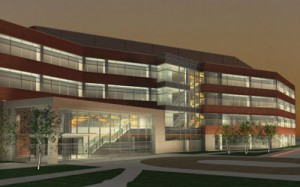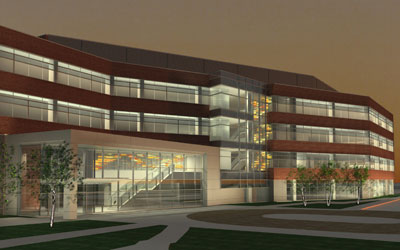 The new construction of the Saunders Research Building (SRB), which houses the Clinical and Translational Science Institute, has been big news to Rochester, as it will create hundreds of new jobs and is projected by the Center for Governmental Research to bring $30 million per year to the community from grants and activity. But there is something else extraordinary about this building, which will house more than 600 scientists, physicians, nurses, statisticians, research administrators, and support staff. It will be the first building at the University to formally receive LEED certification. After breaking ground in May 2009, architects, engineers, and construction workers have worked to provide an ideal setting for research, while constructing a green building.
The new construction of the Saunders Research Building (SRB), which houses the Clinical and Translational Science Institute, has been big news to Rochester, as it will create hundreds of new jobs and is projected by the Center for Governmental Research to bring $30 million per year to the community from grants and activity. But there is something else extraordinary about this building, which will house more than 600 scientists, physicians, nurses, statisticians, research administrators, and support staff. It will be the first building at the University to formally receive LEED certification. After breaking ground in May 2009, architects, engineers, and construction workers have worked to provide an ideal setting for research, while constructing a green building.
As you walk through the front door, you are swept into a large atrium, with Forest Stewardship Council (FSC) certified wood panels lining the walls. Continuing through the hallway, you’ll see suites of conference rooms and classrooms, perfect for holding meetings and events, as well as a satellite operation of the Clinical Research Center. You’ll find researchers in community and preventive medicine, neurological disorders, cancer, pediatrics, cardiovascular disease, emergency medicine, biostatistics and bioinformatics, and human experimental therapeutics as you make your way to the higher floors. Each floor has an open layout floor plan, which is designed to facilitate interaction and collaboration between researchers.
What might not be as readily visible as you circle the building, is all of the green features the building provides. The large glass windows, which line the building, are energy efficient, and yet allow light to brighten the rooms reducing the need for artificial lighting. The lighting system runs on a sensor, so the lights dim when there is enough daylight, and shut off when offices are unoccupied. Part of the roof was constructed with a highly reflective white surface, which is intended to reduce the building’s and University’s overall “heat island effect”. The white roof was chosen as a more sustainable option, although the University was aware that its square footage would not be sufficient to obtain LEED credit points for this feature. The greater goal in designing this building was to make the right sustainable choices, rather than focusing on items that would only gain points in the LEED certification process.
Sustainable site features include porous pavement for SRB parking areas. The porous pavement system includes an underlying drainage system that directs storm water runoff to a rain garden. The rain garden will filter water with native species of plants. Other site features include zero irrigation and sustainable plants near the north and south entries to the building. In addition “preferred parking” spaces will be located nearest the entry of the building for those parkers having Low Emission, Fuel Efficient (LEFE) vehicles.
Back inside the SRB, the heating and cooling system also runs efficiently. The duct and piping were sealed during the construction phase to prevent contaminant from entering the system prior to start-up. One of the 4 large 55,000 cfm air handlers use Heat Wheel technology a system that uses heat recovery which takes heat released from the exhaust side and transfers it back to the supply side, instead of being wasted and released outside. These heating and cooling efforts coupled with the enhanced building envelope have paid off and the building is expected to perform approximately 15% above the standards required by the American Society of Heating, Refrigerating, and Air Conditioning Engineers (ASHRAE).
During the construction of the SRB, the committed construction crew diverted 75% of waste away from landfills. Some of these methods for diverting waste included grinding up drywall to use as soil, recycling metal, paper, and cardboard, and recycling concrete and brick.
The addition of the SRB provides hundreds of jobs, a home to groundbreaking research, and will more than likely receive LEED Silver Certification (and with a chance for Gold), for its consistent efforts in constructing and maintaining a sustainable building. For more information on the project, please visit: http://www.urmc.rochester.edu/news/saunders-research-building/elements.cfm.

